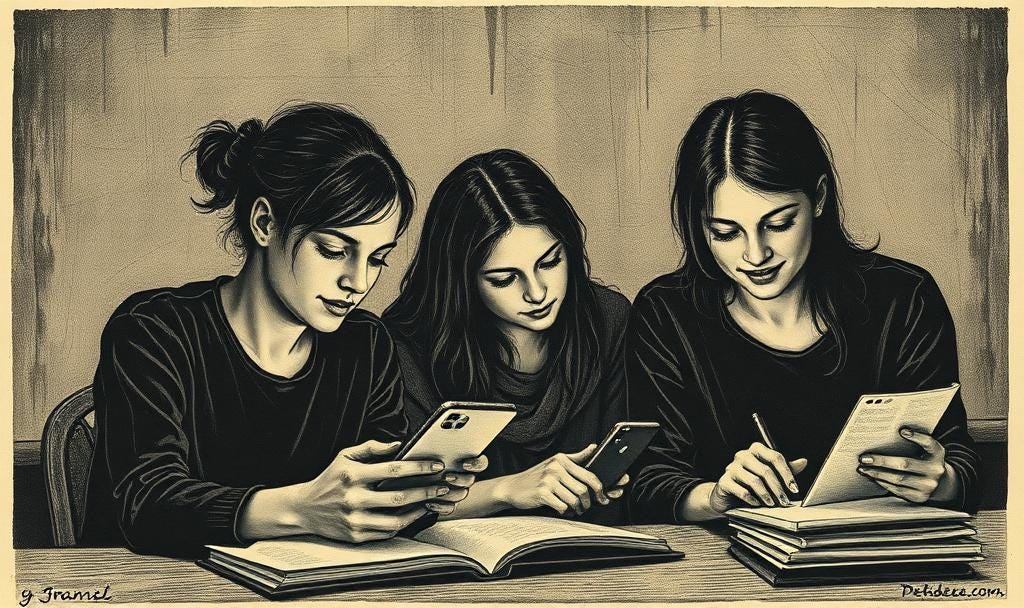The AI Ate My Homework: Equalizer, Cheater, or Just the New Normal?
How GenAI is rewriting the rules of effort, equity, and education—faster than the school board can say “plagiarism.”
The debate over kids using generative AI (GenAI) for schoolwork has reached a fever pitch, with teachers and parents scrambling to keep up with change, as tools like ChatGPT, Gemini, and Claude become nearly ubiquitous in classrooms. Fox News recently spotlighted a high school English teacher who went viral after quitting, blaming ChatGPT for killing effort, literacy, and presumably, the Oxford comma. But as the dust settles, it’s clear AI isn’t going anywhere—and educators are left to figure out how to grade fairly in this new landscape.
AI’s adoption among today’s students is nothing short of explosive. In the past year, the percentage of K-12 students using ChatGPT weekly has jumped to 48%, with nearly half of teachers also reporting weekly use. Only about 20% of students say they’ve never used generative AI. This isn’t a tech fad—it’s a pedagogical jailbreak. Students are rethinking assignments; teachers are rethinking their entire reality.
Yet, public opinion surveys reveal a more complex picture. A recent Pew survey found that only 6% of teachers believe AI does more good than harm in K-12 education, while a quarter say it does more harm than good. The rest are split or unsure, reflecting deep ambivalence. High school teachers are the most skeptical, with 35% saying AI’s negatives outweigh its positives at that level. Concerns about plagiarism, reduced student effort, and the potential for AI to undermine genuine learning are widespread.
Despite fears, there’s an argument to be made that using AI doesn’t eliminate the need for skill—it just changes the game. Even with a powerful AI model, writing a compelling paper or solving a tough math problem requires critical thinking, creativity, and the ability to effectively prompt and refine AI output. Like steroids in sports, injecting AI doesn't make you a star—it just makes your shortcuts faster. You still need skills, discipline, and the digital-age equivalent of game sense.
New academic research backs this up: a prominent meta-analysis of 51 studies published between November 2022 and February 2025 found that ChatGPT can significantly improve student learning performance, especially in skill-based courses, but its impact depends on how students use it and what they’re trying to learn. Interestingly, AI’s advantage is less pronounced in project-based or creative tasks, preserving space for human ingenuity.
As with any industry disruption, there will be winners and losers. Some students who struggle with traditional tests may thrive in an AI-augmented environment, where the ability to leverage technology becomes a new form of literacy. In fact, 56% of students in a recent survey said AI reduced their math anxiety (apparently, the fear of long division fades when a computer’s doing the work), and 21% reported improved scores thanks to AI tools. But there’s a risk that access to AI could deepen existing divides—students from wealthier backgrounds may have more reliable access to advanced tools, while others are left behind. Nonprofits and public programs are pushing for ‘AI for every child,’ echoing Google.org’s recent $25 million pledge to support AI education for underserved students.
Teachers, for their part, are resigned to the future—96% believe AI will be baked into education within a decade. The challenge is to create clear guidelines, invest in AI literacy, and find ways to grade students on the curve of effort, creativity, and mastery, not just the knack for cranking out a passable essay with a chatbot. As with any disruptive technology, the goal isn’t to ban or blindly embrace AI, but to harness it to elevate learning for all students, while keeping a close eye on fairness, integrity, and opportunity.



